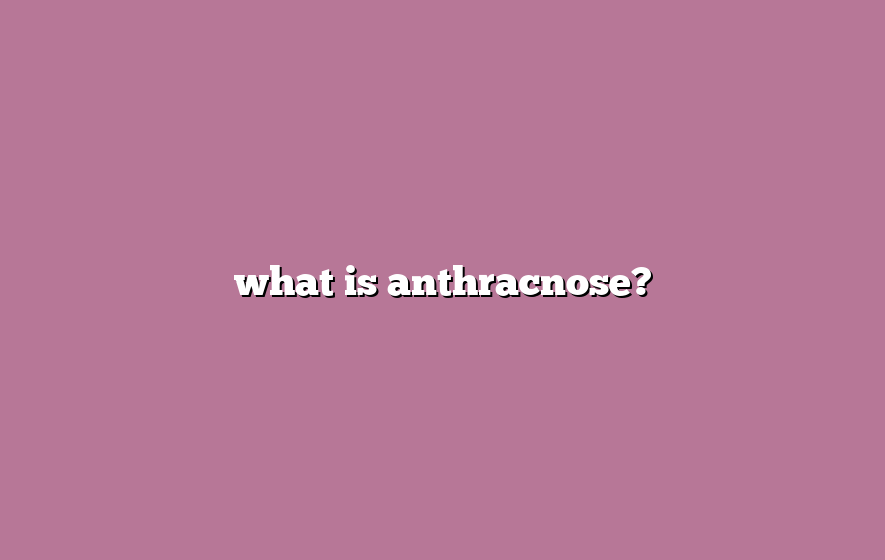Anthracnose is a common fungal disease that affects a wide range of plants, including trees, shrubs, and crops. It is caused by different species of fungi in the order Diaporthales. Anthracnose can cause significant damage to plants, leading to defoliation, reduced vigor, and even plant death if left untreated. Understanding the causes, symptoms, and management techniques is crucial for effectively dealing with this disease.
Introduction
In this article, we will delve into the world of anthracnose, exploring its definition, causes, symptoms, and management strategies. Whether you are a gardener, farmer, or plant enthusiast, this comprehensive guide will provide you with valuable insights to combat this persistent fungal disease.
Understanding Anthracnose
What is Anthracnose?
Anthracnose refers to a group of fungal diseases caused by various species within the Diaporthales order. These fungi primarily thrive in warm and humid climates, making anthracnose a prevalent issue in many regions worldwide. The disease manifests as dark, sunken lesions on various parts of the plant, including leaves, stems, and fruits.
Causes of Anthracnose
The primary factors contributing to the development of anthracnose are favorable environmental conditions, susceptible plant hosts, and the presence of fungal pathogens. Warm and wet weather creates an ideal breeding ground for fungal spores to germinate and infect plants. Additionally, stressed or weakened plants are more susceptible to anthracnose, as their natural defense mechanisms may be compromised.
Symptoms and Identification
Anthracnose can display different symptoms depending on the plant species affected. Let’s explore the common manifestations of this fungal disease:
Leaf Anthracnose
Leaf anthracnose typically presents as irregularly shaped lesions on the foliage. These lesions may start as small, water-soaked spots that gradually enlarge and darken. In severe cases, the leaves may become distorted, yellow, and eventually drop prematurely.
Stem Anthracnose
Stem anthracnose is characterized by sunken lesions or cankers on the stems. These cankers may girdle the stem, leading to wilting, dieback, and even plant death. Infected stems often show discoloration and may exhibit oozing of dark, sticky sap.
Fruit Anthracnose
Fruit anthracnose affects various crops and fruits. Infected fruits develop sunken lesions with dark, concentric rings. The affected areas become soft and decayed, rendering the fruits unmarketable and prone to secondary infections.
Impact on Plants and Crops
Economic Impact
Anthracnose poses significant economic challenges for farmers and agricultural industries. The disease can lead to reduced crop yield and quality, resulting in financial losses. In sectors such as fruit production, where appearance and marketability are crucial, anthracnose-infected fruits may be rejected or sold at lower prices.
Agricultural Impact
In agriculture, anthracnose can have a profound impact on the overall health and productivity of plants. Weakened plants are more susceptible to other diseases, pests, and environmental stresses, further exacerbating crop losses. The spread of anthracnose within a field or orchard can also contribute to the overall decline of plant health and biodiversity.
Management and Prevention
Effective management and prevention strategies are essential for controlling anthracnose and minimizing its impact on plants and crops. Here are some key approaches:
Cultural Practices
- Sanitation: Remove and destroy infected plant materials to prevent the spread of the disease.
- Pruning: Proper pruning techniques can improve air circulation and sunlight penetration, creating an unfavorable environment for fungal growth.
- Water Management: Avoid overwatering and use irrigation methods that keep the foliage dry.
- Crop Rotation: Rotate susceptible crops to break the disease cycle and reduce the buildup of pathogens in the soil.
Chemical Control
In severe cases or for high-value crops, chemical control measures can be employed. Fungicides specifically formulated for anthracnose management can help suppress the disease. It’s important to follow the instructions and guidelines provided by local agricultural authorities and manufacturers to ensure safe and effective application.
Conclusion
Anthracnose is a fungal disease that poses a significant threat to plants and crops. Understanding its causes, symptoms, and management strategies is crucial for preventing and mitigating its impact. By implementing proper cultural practices, maintaining plant health, and employing appropriate control measures when necessary, farmers, gardeners, and plant enthusiasts can effectively manage anthracnose and safeguard their plants.
FAQs
Q1: Can anthracnose affect both ornamental plants and agricultural crops? Yes, anthracnose can affect a wide range of plants, including both ornamental plants and various agricultural crops.
Q2: Can anthracnose be spread from plant to plant? Yes, anthracnose can spread through various means, including rainwater, wind, insects, and human activities such as pruning and handling infected plant material.
Q3: Are there any resistant plant varieties available to combat anthracnose? Yes, in some cases, plant breeders have developed resistant varieties that show increased tolerance or resistance to anthracnose. It is advisable to consult with local agricultural extension services or nurseries for information on resistant cultivars suitable for your area.
Q4: Can cultural practices alone effectively manage anthracnose? Cultural practices play a crucial role in managing anthracnose; however, in severe cases, additional measures such as chemical control may be necessary for effective disease management.
Q5: How can I identify anthracnose on my plants? Anthracnose can be identified by the presence of characteristic dark, sunken lesions on leaves, stems, or fruits. If you suspect anthracnose on your plants, it is recommended to consult with a local plant disease expert or extension service for proper diagnosis.

